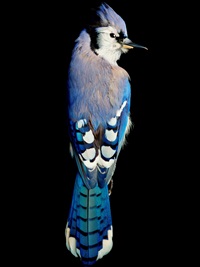Ornithology Resources
Online Database

Our online database includes 191,581 specimens and 163,797 collection objects.
Click here to access our online database for Ornithology
VIREO (VIsual REsources for Ornithology)

 |
|
VIREO (vireo.ansp.org), the most comprehensive bird image bank in the world, was started in 1979 to provide a centralized and well-curated collection of avian photos for scientific and public use. VIREO contains more than 150,000 images representing over 7,000 species from around the world. Its contributors include some of the best wildlife photographers around.
VIREO licenses bird images for a wide variety of commercial and non-profit uses. It also sells digital images for lectures. There are more than 72,000 images in VIREO's online bird image database. More are being added daily.
|
Photography © Mark Laita
Curation Projects

Collection Cabinet Upgrades
The Academy of Natural Sciences was founded in 1812 by a group of Philadelphians with a shared interest in natural science and history. Over the last two centuries the Academy has worked to maintain the highest levels of curation quality for collection specimens. In the late 1970s, the Academy became the first natural history museum to house its bird collection on a space saving compactor system. In the spring of 2001, the Ornithology Department made the next major step in collection upgrades by replacing outdated wooden specimen storage cabinets and trays with modern steel cases and aluminum trays. The end result was rehousing all bird skins in 165 insect-proof cabinets that were larger than the old wooden cases to provide a stable storage environment and room for future expansion of the collection.
Funding partners involved with the collection upgrade include the National Science Foundation ($350,000), Institute of Museum and Library Services ($47,000), Pennsylvania Historic and Museum Commission ($15,000), Pennsylvania Game Commission ($13,000), and private donations, all with matching funds from the Academy's Collections Care Endowment Fund ($275,000). The physical transfer of study skins from old wooden cases to new modern cabinets was made possible through the help of as many as 15 volunteers (many from the DVOC).
Frozen Tissue Collection Upgrades
Frank Gill and Fred Sheldon established the frozen tissue collection at the Academy nearly 20 years ago. Just as there have been monumental changes in the use of molecular data in systematics, so have there been important changes in the manner in which molecular collections are maintained. In the last year we have worked to upgrade the storage quality and organization of the tissue collection. Working mainly with money from the Laboratory of Molecular Systematics and Ecology and the Ornithology Department, Tatyana Livshultz, and Nate Rice have endeavored to bring the tissue collection up to modern collection standards.
The first phase of this project was purchasing a new ultracold freezer with a carbon dioxide backup system. The carbon dioxide backup, combined with a diesel generator backup electrical system guard against any freezer troubles due to electrical interruptions. Robert Driver was hired to help transfer larger sized tissue tubes into the standard 1.8mL sized tube used in most of the Academy's tissue collection. The final phase of the project involves affixing new top and side labels to older tubes. Missing tubes and lost samples will then be noted in the collection database.
Digitizing the Type Collection
The Academy's collection of bird type specimens is rich and varied with representative specimens from nearly all continents. Many important North American type specimens are housed in the collection due to early taxonomic work by Alexander Wilson, John James Audubon, John Cassin, and Witmer Stone. One of the strengths of the Academy's collection is the impressive series of South American bird specimens. All of the historical and recent work in South America has led to a correspondingly impressive compliment of type specimens. Future collection upgrade projects will aim to digitize the type collection and publish a modern listing of our type specimens.